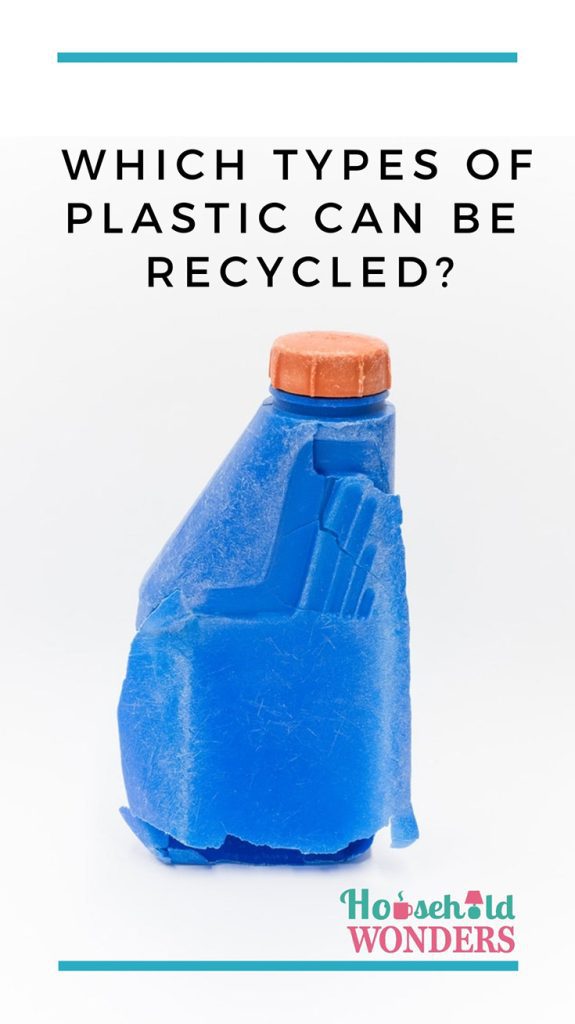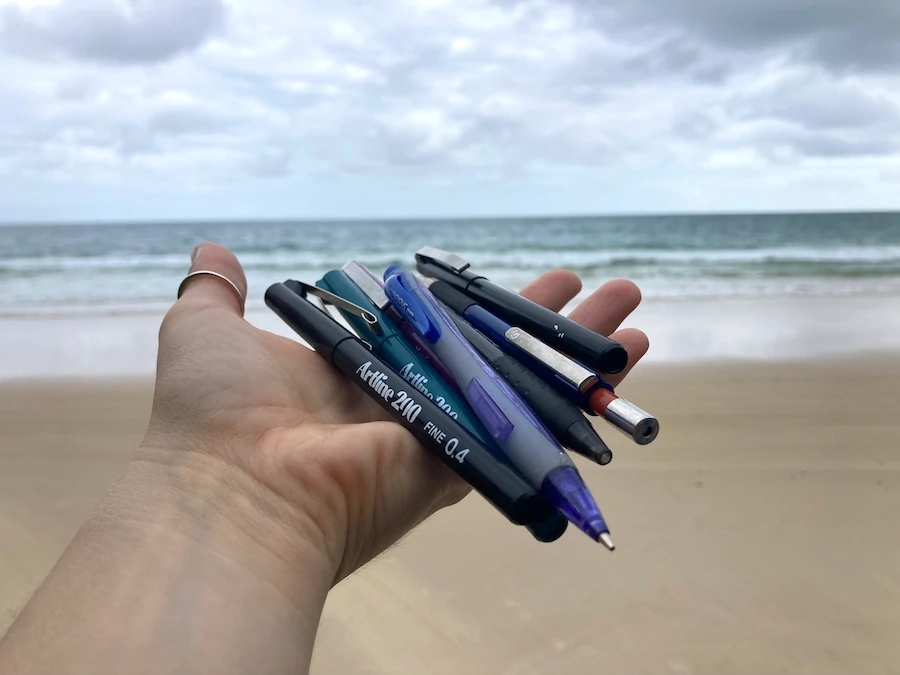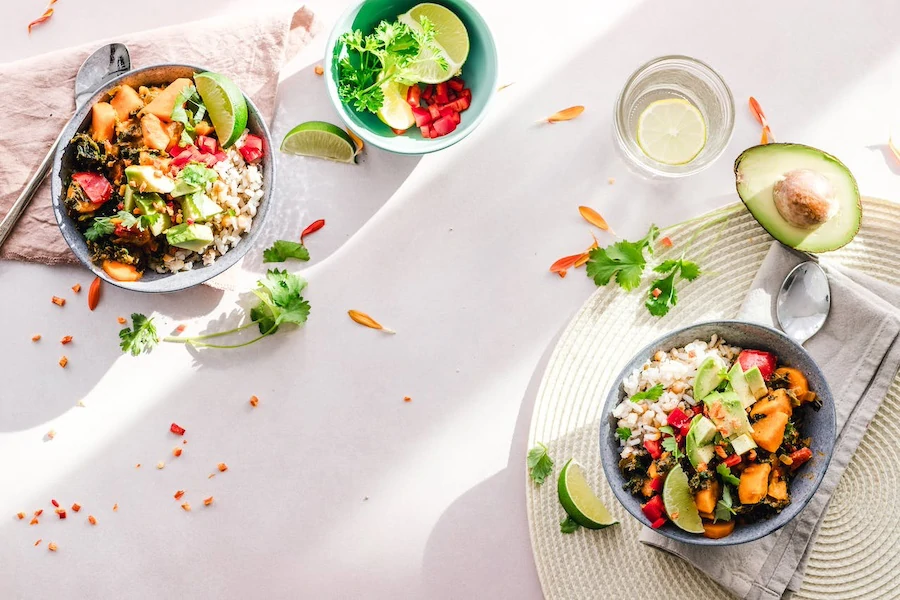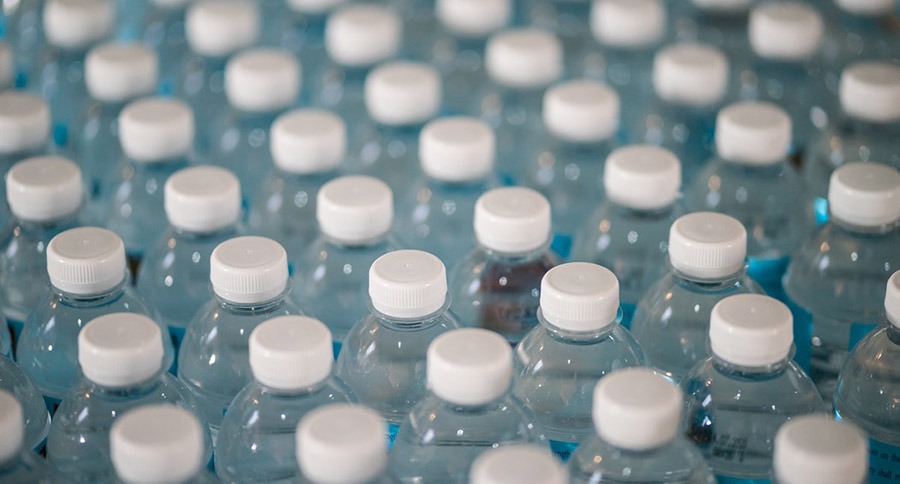
Plastics are one of the most widely used consumer materials in the world. Nearly every product we consume is packaged with plastic. There are so many plastics out there that I was confused about which ones can be recycled and which ones cannot.
So which types of plastic can be recycled? There are seven plastic codes printed on plastic product labels, however, not all of them can be recycled. The key is understanding which ones can be recycled and reducing your use of the ones that cannot.
Plastic Recycling Guide
Just Look at the Symbols
Every plastic has a “chasing arrow” recycling symbol with a resin identification code (RIC) number on the inside. Just because the plastic has this recycling symbol does not mean it is recyclable. The number on the inside of the symbol and the abbreviation are the important factors.
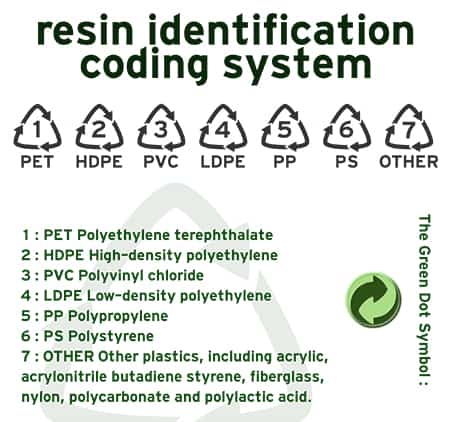
The symbols will be placed on the back of the product label, usually printed very small in the corner. This will indicate the type of plastic. You may also see the symbol molded into the plastic.
Here are the seven classifications for plastics and the recycling information for each type:
#1 PET: Polyethylene Terephthalate
This one of the most common forms of plastic that is clear, strong, and lightweight. PET is actually polyester, (a synthetic resin also used in synthetic textile fibers) but its primary use is for packaging food and beverages, especially soda and water bottles. Mostly all single-serving and 2-liter bottles of soda and water sold in the United States are made from PET.
PET plastic bottles are generally safe but should not be reused as bacteria can grow on the surface due to film from our lips and backwash when drinking. In order to properly clean and decontaminate, it would require the use of harmful chemicals. PET is durable but can degrade quickly when exposed to sunlight, heat, or prolonged making it a poor reusable option.
PET plastic is recyclable but in the United States, only 30% is recycled yearly which falls behind Europe’s rate of 50%. Despite these less than ideal rates, PET is the most recycled plastic in the world. When recycled, the plastic is shredded and crushed into tiny flakes and then reprocessed to make new PET bottles or polyester fibers and textiles. These fibers shorten over time so they can only be recycled 7-9 times before it becomes no longer recyclable.
Products that are packaged with PET plastic:
- Soft drink and water bottles
- Cooking oil
- Salad dressings
- Toiletries including mouthwash, shampoo, and liquid hand soap
- Cleaning products
- Tennis balls
Conclusion: PET is recyclable but not reusable. It is accepted at most recycling centers throughout the world. You can reduce your PET plastic use by opting to use reusable water bottles and beverage containers. Look for products without excessive disposable plastic packaging. Store your toiletries in reusable glass jars or bottles.
#2 HDPE: High-Density Polyethylene
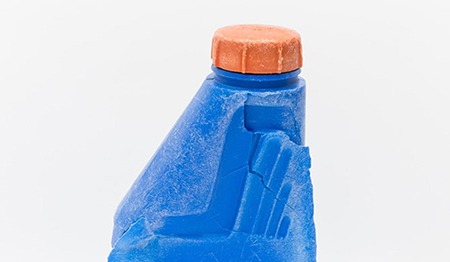
HDPE is a stiff and strong plastic making it an ideal choice for packaging. It is also impact and moisture resistant making it a versatile choice for many outdoor commercial materials.
HDPE is one of the most commonly recycled plastics and is also considered one of the safest forms of plastic as it has a low risk of leaching into foods or liquids. It is a generally safe and reusable option but won’t last forever. It should be recycled when it shows signs of cracking, scuffing, scratches or becomes cloudy and discolored. Avoid exposing HDPE plastic containers to sunlight or excessive heat to prolong their lifespan.
It’s more cost-effective to produce a product from recycled HDPE than to produce a “virgin” plastic (newly manufactured plastic). HDPE can also be beneficial due to its lightweight yet durable properties, making it an excellent alternative to producing heavier materials. This can translate to a lower environmental impact during its production.
Products that are made from HDPE plastic:
- Gallon milk jugs
- Plastic bags
- Tupperware
- Laundry detergent containers
- Toys
- Picnic tables, park benches, and playground equipment
- Truck bed liners
- Plastic lumber and outdoor furniture
- Hard hats and helmets
- Automobile parts
- Underground pipes
- Waste bins and buckets
- Lawn and garden products
Conclusion: HDPE is recyclable and reusable. It is accepted at most recycling centers in the world. By recycling HDPE you prevent it from entering a landfill. Unfortunately, only about 30% of HDPE is actually recycled in the United States with many plastic bags ending up in a landfill or dispersed throughout the environment. It’s important to reduce your use when possible. Instead of plastic Ziploc bags and plastic Tupperware, you can opt for silicone reusable bags or glass food storage containers. When grocery shopping, opt for reusable cloth tote bags instead of standard plastic grocery bags.
#3 PVC: Polyvinyl Chloride
Most people think of white plastic pipes when they hear PVC. Also known as vinyl, PVC is a soft and flexible plastic common for construction and healthcare, but can also be found for personal applications in the home. It has a high tolerance for sunlight and weather conditions making it an ideal material for outdoor products.
PVC is known as a “poison plastic” because it contains numerous toxins that can leach throughout its lifespan. PVC can be a major source of phthalates or “plastic softeners” which can harm children’s health and development by interfering with natural hormone functioning. It has also been linked to birth defects, testicular cancer, and liver problems.
These chemicals also make it very difficult to recycle, with only 1% of PVC actually getting recycled yearly in the United States. When entering a landfill the plastic additives can leach chlorine, carcinogens, and other toxic chemicals into the soil. These chemicals can also contaminate waterways and air quality. Many European countries have adopted policies to ban PVC from landfills.
Most products using PVC require the manufacturing of new “virgin” material for its construction which adds a large environmental impact to its overall production. Some PVC products could be repurposed or “upcycled” but due to its toxic properties, PVC should not be reused for food use or for children.
Products that contain PVC plastic:
- Plastic food wrapping
- Children’s toys and school supplies
- Shower curtains
- Mattress covers
- Pet toys
- Medical materials
- Computer cables
- Plastic pipes for plumbing
- Garden hoses
- Window frames, arbors, and trellises
Conclusion: PVC is not recyclable and not reusable. This is not a very sustainable material and I would suggest avoiding when possible. Avoid plastic food wrapping with PVC by using beeswax food wrap instead. A water-safe drinking garden hose is also a safer option. Look for alternatives that are PVC-free to reduce your exposure to this potentially toxic plastic.
#4 LDPE: Low-Density Polyethylene
LDPE is used to make thin and flexible products you will find on food packaging and consumer goods. Like it’s a close friend to HDPE, it’s mostly used for plastic bags you will find in grocery stores. It’s not as hard or durable as HDPE but is less toxic than other plastics and safe for use with foods.
Products that are made using LDPE plastic:
- Grocery bags
- Shrinkwrap and stretch film
- Dry cleaner garment bags
- Coatings for paper milk cartons and disposable cups
- Squeezable bottles
- Frozen food containers
- Bread plastic bag packaging
- Garbage bag liners
- Adhesives
- Food container lids
LDPE has traditionally not been a very recyclable plastic, however, many recycling centers are changing to adapt to this service. When LDPE is recycled it can be used for building materials including such as plastic lumber, paneling, and floor tiles. Other applications include shipping envelopes, compost bins, garbage cans, and furniture.
Conclusion: products made from LDPE are reusable but not commonly recyclable. Check with your municipality or local recycling facility to see if they accept #4 LDPE plastics. Some supermarkets will also accept LDPE plastic bags for recycling so check with your local grocery store to see if this is possible. You can reuse any LDPE plastic containers you may have for as long as possible. Try to reduce your use of LDPE plastic by switching to alternatives to plastic grocery bags such as cloth tote bags. For food storage, reusable freezer and sandwich bags made from silicone make great eco-friendly alternatives.
#5 PP: Polypropylene
Polypropylene is lightweight yet durable with heat-resistance properties that will be a strong barrier against, moisture, grease, and chemicals. It is widely used with single-use drinking straws but is also the thin plastic packaging that will keep foods such as chips and cereals freshly sealed.
Products that are made using PP plastic:
- Plastic straws
- Disposable diapers
- Plastic bottle tops
- Dairy containers
- Potato chip bags
- Cereals
- Packing tape
- Rope
When recycled, PP can be used to make landscaping borders, battery cases, brooms, bins, and trays. Unfortunately, only 3% of PP plastics get recycled in the United States yearly! Many will end up in landfills and will take 20-30 years to decompose.
Scientists estimate there are more than 8.3 billion plastic straws polluting the shorelines around the world. These single-use plastic straws are wreaking havoc in our waterways and killing marine life. Plastic straws are difficult to recycle due to their thin and bendable shape causing them to fall into the cracks of recycling machinery.
Conclusion: Polypropylene is recyclable and safe to be reused. There has been little demand to recycle #5 polypropylene due to its low worth and cheap production, but more and more recycling providers are beginning to accept it.
You can reduce your PP use by opting for alternatives to single-use plastic straws by switching to reusable drinking straws. Reusable water bottles will also prevent plastic bottle tops from ending up in the landfill. Cloth diapers are a viable and reusable alternative to disposable diapers.
#6 PS: Polystyrene
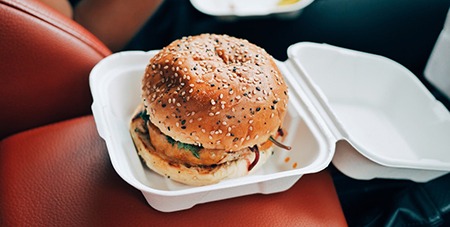
This material is commonly known as “styrofoam”. It’s cheap to produce, lightweight and has many uses. Due to its lightweight properties, it breaks up very easily can spread throughout the environment. Polluted waterways have bits of polystyrene present which can be toxic when ingested by marine life. Styrene, the chemical present in polystyrene, can migrate into food from packaging. The full health effects are still fully unknown, but it’s not a risk I’d be willing to take.
If heated in a microwave with food, it can leach the chemical styrene into the food. This material is widely used even though it’s composed of highly dangerous carcinogens, but many establishments still use it today due to it being such a versatile and cost-effective option.
Due to its toxic chemicals, it’s not commonly recyclable, therefore polystyrene ends up in the landfill accounting for nearly 30% of landfill material in the United States.
Products that are made using PS plastic:
- Takeaway boxes from restaurants
- To-go cups for hot and cold beverages
- Egg cartons
- Foam packaging and “peanut” packaging found when shipping boxes
- Foam insulation
- Underlay sheeting for laminate flooring
- License plate frames
- School lunch trays
The verdict: Polystyrene is not recyclable or reusable. In fact, I would recommend avoiding it completely due to its toxic chemical properties and its detrimental effects on the environment. Look for products and establishments that use eco-friendly packaging alternatives such as biodegradable or compostable paper. You can also opt for reusable food containers and reusable coffee cups.
#7: Other Plastics
This category includes polycarbonates and a variety of different plastic types some of which are recyclable and some of which are not. BPA or bisphenol A is commonly known amongst consumers nowadays due to its unknown and yet potentially harmful effects.
PLA (polylactic acid) is a new type of plastic that is bio-based, made from corn starch. Its bio-based properties make it compostable and can easily be thrown into the compost bin, however, it’s not recyclable. Look for the initials “PLA” or “compostable” under the recycling symbol to be sure.
LEXAN is another polycarbonate that serves as a brand name for the creation of many modern products known for their durability and high-impact strength.
Products that may contain #7 plastics:
- Sunglasses
- Computer casing
- Nylon
- DVDs & CDs
- Baby bottles and sippy cups
- Water cooler bottles
- Automobile parts
- Bulletproof glass
- Kitchenware
The verdict: Most #7 plastics are not recyclable or reusable. The only reusable #7 plastic may be PLA. It’s best to avoid number 7 plastics, especially for children and baby food. Look for plastics that are BPA-free when using for food consumption or storage. Opt for eco-friendly food storage alternatives such as stainless steel or silicone food containers.
Raise Your Awareness
The plastic industry has complied with regulations by making the resin identification (RIC) codes visible to consumers on the packaging, but it’s up to you to be an informed consumer. If you can understand these classifications, you can increase your awareness of how to safely use plastic, correctly recycle, and reduce any additional plastic waste that can be harmful to the environment.
Related Questions
How can I start recycling? Join a recycling program by participating in curbside pickup. They will provide you with designated recycling bins. Contact your local municipality to get started.
Which things are not recyclable? Garbage, food waste, food-tainted items, ceramics, kitchenware, and certain plastics (see above) are not recyclable.
